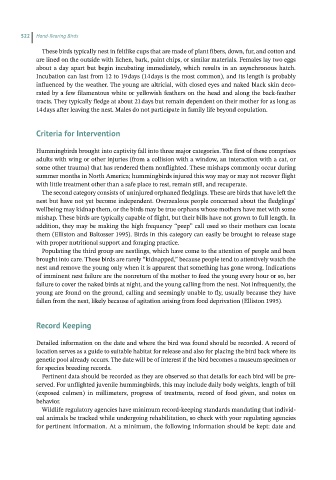Page 524 - Hand rearing birds second
P. 524
522 Hand-Rearing Birds
These birds typically nest in feltlike cups that are made of plant fibers, down, fur, and cotton and
are lined on the outside with lichen, bark, paint chips, or similar materials. Females lay two eggs
about a day apart but begin incubating immediately, which results in an asynchronous hatch.
Incubation can last from 12 to 19 days (14 days is the most common), and its length is probably
influenced by the weather. The young are altricial, with closed eyes and naked black skin deco-
rated by a few filamentous white or yellowish feathers on the head and along the back‐feather
tracts. They typically fledge at about 21 days but remain dependent on their mother for as long as
14 days after leaving the nest. Males do not participate in family life beyond copulation.
Criteriafor Intervention
Hummingbirds brought into captivity fall into three major categories. The first of these comprises
adults with wing or other injuries (from a collision with a window, an interaction with a cat, or
some other trauma) that has rendered them nonflighted. These mishaps commonly occur during
summer months in North America; hummingbirds injured this way may or may not recover flight
with little treatment other than a safe place to rest, remain still, and recuperate.
The second category consists of uninjured orphaned fledglings. These are birds that have left the
nest but have not yet become independent. Overzealous people concerned about the fledglings’
wellbeing may kidnap them, or the birds may be true orphans whose mothers have met with some
mishap. These birds are typically capable of flight, but their bills have not grown to full length. In
addition, they may be making the high frequency “peep” call used so their mothers can locate
them (Elliston and Baltosser 1995). Birds in this category can easily be brought to release stage
with proper nutritional support and foraging practice.
Populating the third group are nestlings, which have come to the attention of people and been
brought into care. These birds are rarely “kidnapped,” because people tend to attentively watch the
nest and remove the young only when it is apparent that something has gone wrong. Indications
of imminent nest failure are the nonreturn of the mother to feed the young every hour or so, her
failure to cover the naked birds at night, and the young calling from the nest. Not infrequently, the
young are found on the ground, calling and seemingly unable to fly, usually because they have
fallen from the nest, likely because of agitation arising from food deprivation (Elliston 1995).
Record Keeping
Detailed information on the date and where the bird was found should be recorded. A record of
location serves as a guide to suitable habitat for release and also for placing the bird back where its
genetic pool already occurs. The date will be of interest if the bird becomes a museum specimen or
for species breeding records.
Pertinent data should be recorded as they are observed so that details for each bird will be pre-
served. For unflighted juvenile hummingbirds, this may include daily body weights, length of bill
(exposed culmen) in millimeters, progress of treatments, record of food given, and notes on
behavior.
Wildlife regulatory agencies have minimum record‐keeping standards mandating that individ-
ual animals be tracked while undergoing rehabilitation, so check with your regulating agencies
for pertinent information. At a minimum, the following information should be kept: date and

